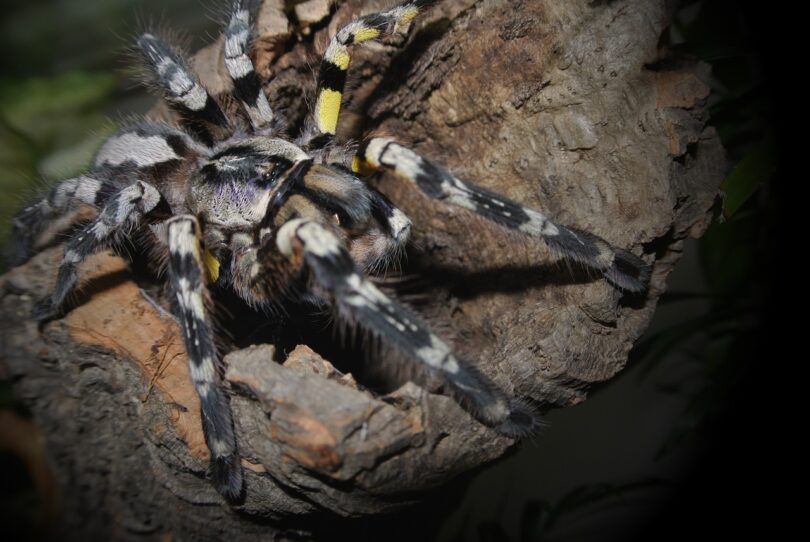Tarantulas are formidable spiders and, contrary to popular belief, they are not able as jumping spiders. As an enthusiast with years of experience researching these incredible arthropods, I can say that different spiders require very distinct approaches when it comes to hunting prey and surviving in their environment.
Though tarantulas may be able to take a few small hops or short jumps for very brief distances, they don’t possess the impressive jumping ability like true “jumping” spiders do. In this blog post, we’ll explore what kind of mobility tarantulas actually have and how they use it for stalking prey rather than leaping from one place to another.
With their powerful legs and fangs adapted for pinning down victims instead of quick hunts akin to maniacal jumps seen by other species of spider, we will better understand just why tarantula’s lack the skillset some think they have.
So find out now all about the amazing world of tarantula’s dynamic movement through context-specific behaviors that help them thrive–and maybe even teach us a thing or two about our own survival techniques!
Key Takeaways
- Tarantulas do not possess the impressive jumping ability like true “jumping” spiders, often only able to take small hops or short jumps for brief distances.
- Jumping spiders have evolved to jump as a means of hunting and locomotion with powerful legs, much lighter body, sharp claws that allow them perch on surfaces and specialized setae that help promote secure adhesion for hard landings after jumping off inclined surfaces.
- Terrestrial Tarantulas exhibit very different predation strategies relying mainly on soil displacement cues like vibration signature analysis or smell rather than being quick jumpers.
- Tarantula anatomy consists of eight articulating walking legs; two chelicerae (jaws) with venomous fangs at its tip; plus two more modified appendage-like structures called pedipalps aiding in tactile sensing but can also be used defensively against predators or manipulating food during consumption.
- Jump induced injury is a risk when attempting to jump especially high hence pet owners should exercise necessary caution by providing an enclosure of an appropriately adjusted height based on the tarantula species they own.
Can Tarantulas Really Jump?
Contrary to traditional belief, tarantulas do actually jump – but only in the case of a few species. In this section, we’ll explore the different ways in which tarantulas can move about and discuss why jumping is an impossibility for them.
The truth about tarantula mobility
While many people may think that tarantulas have the ability to leap incredible distances, scientific evidence does not support this claim. Tarantulas are only able to jump very short distances – usually no more than a few inches in height and sometimes just brief hops across a surface.
This is because they evolved with an evolutionary advantage over fast-moving prey like crickets which means they don’t need strong jumping tactics for hunting effectively. Instead, their sensing organs allow them to detect vibration in the ground which alerts them of potential prey long before it comes into contact with them.
Arboreal species can also climb walls and ceilings using small bristles on their feet but do lack any kind of flying capabilities entirely due to their limited aerodynamics shape compared to some other spiders such as orb weave spiders or jumping spiders that naturally have much better mobility regardless of habitat type.
Species-Specific Jumping Behaviors
Understand the difference between the jumping capabilities of tarantulas in different habitats, and how this influences their mobility. Read on to discover more!
Arboreal species vs. tarantulas and their jumping capabilities
Arboreal species have evolved to jump as both a means of locomotion and hunting. These species are capable of decent jumps, in comparison with terrestrial tarantulas that can only move slowly and deliberately due to their lack of jumping ability.
Arboreal spiders agility comes from their anatomy which includes strong but lightweight exoskeletons, powerful legs with sharp claws that allow them to perch on vertical surfaces and the presence of specialized spine-like setae (hairs) along their feet that help promote secure adhesion for hard landings after jumping off inclined surfaces.
Additionally, arboreal tarantulas are known to exhibit jumping behavior, especially species from the genera Psalmopeus or Avicularia, particularly when they haven’t reached maturity, and their weight is still relatively low.
Contrarily, Terrestrial Tarantulas exhibit very different predation strategies; these nocturnal predators use soil displacement cues like vibration signature analysis or smell rather light like most other spiders.
The Science Behind How Tarantulas Jump
An exploration of how tarantulas move using their unique anatomy in combination with surrounding conditions, such as the size and texture of the terrain.
Understanding tarantula anatomy and movement
Tarantulas have two distinct body parts: a cephalothorax and an abdomen. The cephalothorax is composed of a hardened plate which shields the structure behind it, including vital organs like the heart and digestive system.
On top of this hard exterior are eight legs that support their mobility while allowing a tarantula to grab onto prey items with relative ease as they inched over them. Two additional smaller appendages – called pedipalps – located on either side of the mouthparts are used for touching, feeling, and manipulating prey before consuming it.
The prosoma holds twelve appendages in total, said components helping contribute greatly to tarantulas hunting behaviors; consisting ofeight articulating walking legs that create movement, two chelicerae (jaws) for capturing prey with venomous fangs at its tip; plus two more modified appendage-like structures known as pedipalps that aids into tactile sensing but can also be used defensively against predators or to manipulate food during consumption.
Potential Risks of Tarantula Jumping
Jump-induced injuries are a common risk of falling for tarantulas and can occur any time they attempt to jump, so owners should be prepared with height safety precautions.
Safety considerations for tarantulas and their owners
Tarantulas have the capacity to jump very short distances, though amusing to watch, they are equipped with powerful legs that can propel them upward or away from perceived danger. While tarantulas rarely bite people and when they do it is typically no more painful than a bee sting in terms of toxicity, potential dangers for owners still exist.
Tarantulas move incredibly quickly and unpredictably when distressed which means that if not handled properly could cause an owner or themselves significant injury as their reflexes allow them to spring out of harm’s way quicker than you may expect.
Additionally, care should be taken over temperature control as too high or too low temperatures can create added distress for your pet tarantula which may lead them into jumping off enclosures risking further injury.
Conclusion
Tarantulas are a unique species of spider and have different abilities than jumping spiders. While tarantulas may be capable of jumps or short hops, they primarily use their large legs and fangs to capture prey in patient ambushes or stalking tactics.
This is distinct from the agile movement seen in jumping spiders that often rely on quick bursts of energy to perform acrobatic feats for hunting food. It’s important to understand and recognize these features specific to each species so we can appreciate their individual strategies for survival and ecological roles within our environment.
FAQs
1. Can a tarantula jump?
Yes, some tarantulas are able to jump using their muscular back legs and special sensors that can detect movements in the air.
2. How far can a tarantula jump?
Tarantulas typically only make jumps between 5-10 cm in distance.
3. How high can a tarantula jump?
The maximum height an average arboreal tarantula is capable of jumping is typically around 20cm (about 8 inches).
4. What triggers a tarantula’s ability to jump?
A variety of factors such as disturbances on its web or nearby vibrations can trigger jumping behavior in a tarantula as they perceive it as an attack by predators.







